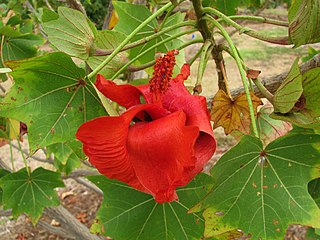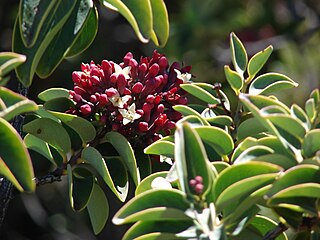Hawaiian hibiscus are seven species of hibiscus native to Hawaii. The yellow hibiscus is Hawaii's state flower. Most commonly grown as ornamental plants in the Hawaiian Islands are the non-native Chinese hibiscus and its numerous hybrids, though the native Hibiscus arnottianus is occasionally planted.

Abutilon menziesii, known as Koʻoloaʻula in Hawaiian, is an endangered species of flowering shrub in the mallow family, Malvaceae, that is endemic to Hawaii.

Hibiscadelphus is a genus of flowering plants that are endemic to Hawaiʻi. It is known by the Native Hawaiians as hau kuahiwi which means "mountain Hibiscus". The Latin name Hibiscadelphus means "brother of Hibiscus". It is distinctive for its peculiar flowers, which do not fully open. Hibiscadelphus is in the family Malvaceae, subfamily Malvoideae. Several of the species in this small genus are presumed extinct, as a result of coextinction with their primary pollinators, the Hawaiian honeycreepers.

Hibiscadelphus distans is an extremely rare species of flowering plant in the mallow family, Malvaceae, that is endemic to the island of Kauaʻi in Hawaii. It is known as hau kuahiwi in Hawaiian, which means "upland Hibiscus tiliaceus." It is a bush or small tree with heart-shaped leaves and yellow flowers and grows at between 1,000 and 1,800 feet in the remnants of native dry forests. Despite its rarity, it is believed to be the only surviving species in the genus Hibiscadelphus which is only known from Hawaii, the other five species having recently become extinct in the wild, some being known from only a single plant.

Sida fallax, known as yellow ilima or golden mallow, is a species of herbaceous flowering plant in the Hibiscus family, Malvaceae, indigenous to the Hawaiian Archipelago and other Pacific Islands. Plants may be erect or prostrate and are found in drier areas in sandy soils, often near the ocean. ʻIlima is the symbol of Laloimehani and is the flower for the islands of Oʻahu, Hawaiʻi, and Abemama, Kiribati.

Kokia cookei is a small, deciduous tree commonly known as the kokiʻo, Molokaʻi treecotton, Cooke's kokiʻo, or Molokaʻi kokiʻo.
Hibiscadelphus crucibracteatus is an extinct species of flowering plant in the family Malvaceae that was endemic to Hawaii, on the island of Lanai.

Hibiscadelphus giffardianus is a species of flowering plant in the mallow family Malvaceae that is endemic to the Big Island of Hawaii.

Hibiscadelphus hualalaiensis is a species of flowering plant in the mallow family Malvaceae that is endemic to the Big Island of Hawaii.

Hibiscadelphus wilderianus, also known as the Maui hau kuahiwi is an extinct species of flowering plant in the family Malvaceae that was endemic to Hawaii.
Hibiscadelphus woodii, or Wood's hau kuahiwi, is a species of flowering plant in the family Malvaceae endemic to Kauai, Hawaii.
Kokia kauaiensis, the Kauai treecotton or Kauaʻi Kokiʻo, is a species of flowering plant in the mallow family, Malvaceae, that is endemic to Kauaʻi, Hawaii.

Brighamia rockii, known as the Molokai ohaha or Pua ʻala in Hawaiian, is a species of flowering plant in the bellflower family, Campanulaceae, that is endemic to the island of Molokaʻi in Hawaii. Pua ʻala inhabits mesic shrublands and forests on rocky cliffs from sea level to 470 m (1,540 ft) on the island's northern windward coast. Associated plants include ʻōhiʻa lehua, alaheʻe, lama, ʻūlei, and naupaka.

Santalum haleakalae, known as Haleakala sandalwood or ʻIliahi in Hawaiian, is a species of flowering tree in the sandalwood family, that is endemic to the islands of Maui, Lanai, and Molokai in the Hawaiian Islands, part of the United States. It grows in subalpine shrublands at elevations of 1,900 to 2,700 m, especially on the slopes of Haleakalā.

Geranium multiflorum is a rare species of geranium known by the common names manyflower geranium, or manyflowered cranesbill. It is endemic to Hawaii, where it is known only from Haleakalā, the main volcano on the island of Maui. It was federally listed as an endangered species in 1992. Like other Hawaiian geraniums, this plant is known as hinahina and nohoanu.

Cyperus pennatiformis is a rare species of sedge known by the common name coastal flatsedge. It is endemic to Hawaii, where it grows on the islands of Maui, Kauai, and Laysan. It is a federally listed endangered species of the United States.

Sanicula purpurea is a rare species of flowering plant in the carrot family known by the common names purple-flower black-snakeroot and purple-flowered sanicle. It is endemic to Hawaii, where it is known from Maui and from the Koolau Mountains on the island of Oahu. It is threatened by the degradation of its habitat. It was federally listed as endangered species of the United States in 1996.

Solanum incompletum is a rare species of flowering plant in the family Solanaceae known by the common names thorny popolo and popolo ku mai. It is endemic to Hawaii, where it occurs today on the islands of Maui, Lanai, and Hawaii. It is threatened by the destruction and degradation of its habitat. It is a federally listed endangered species of the United States.
Tetramolopium arenarium is a rare species of flowering plant in the family Asteraceae known by the common name Maui tetramolopium. It is endemic to Hawaii, where it is known only from the island of Hawaii. It is extirpated from Maui. It is threatened by the degradation of its habitat. It is a federally listed endangered species of the United States.
Tetramolopium lepidotum is a rare species of flowering plant in the family Asteraceae known by the common name Waianae Range tetramolopium. It is endemic to Hawaii, where today it is known only from the Waianae Mountains on the island of Oahu. It is threatened by habitat degradation caused by feral goats and pigs and introduced species of plants.












